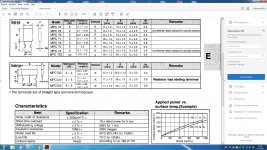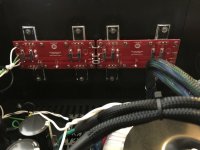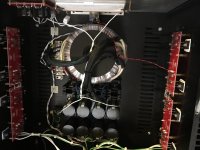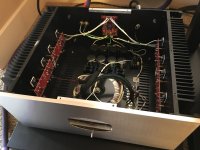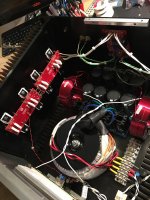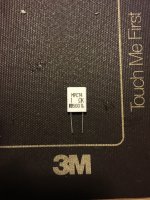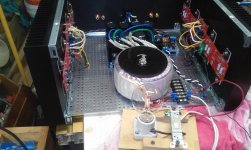As far as I am aware there is no such thing as zero inductance resistor. Even film resistors, if cylindrical in shape, have some inductance. This was characterised in a Vishay document that I cannot locate now, where all resistors below about 500 ohm are inductive and above are capacitative.
Note the operative words 'almost totally eliminated' in the Mills docs: http://www.vishay.com/docs/49484/mra_vmn-pt0404.pdf
The Mills are great products no doubt, but don't expect zero inductance at low ohmic values, it's not really possible. Most datasheets will not characterise parasitics anyway, but a typical set of values can be seen here:
Resistor inductance » Resistor Guide
Note the operative words 'almost totally eliminated' in the Mills docs: http://www.vishay.com/docs/49484/mra_vmn-pt0404.pdf
The Mills are great products no doubt, but don't expect zero inductance at low ohmic values, it's not really possible. Most datasheets will not characterise parasitics anyway, but a typical set of values can be seen here:
Resistor inductance » Resistor Guide
The only one concern which I pulled out: inductance in resistors (include parasitic one) can impact very high frequencies passages. Do we have such situation here? I assume we are dealing mainly with low frequencies. I scratch my head to go for Mills or not. I need 36 prices with investment of about $100. Little itchy....Will I have different sound is also unknown until someone is already tried that compare.
Sent from my iPhone using Tapatalk
Sent from my iPhone using Tapatalk
Few nH of inductance do not affect the high frequencies. Output inductirsbin amplifiers which have them, for example, tend to be around 5uH, which is a few orders of magnitude above that of even a basic wire wound resistor.
There are issues around stability if you use lateral MOSFETS with inductance in the source circuit - can cause oscillation, but for the F5T/vanilla built with vertical devices, this should not be an issue.
There are issues around stability if you use lateral MOSFETS with inductance in the source circuit - can cause oscillation, but for the F5T/vanilla built with vertical devices, this should not be an issue.
I see. Thank you all for very knowable answers. I'll see if my budget will allow such move and also I need to concern about dismantling boards from heat sinks... Not that easy and can be destructive procedure. Let me ask you that question: if that would be you, then will you goo and replace these R to Mills?
Sent from my iPhone using Tapatalk
Sent from my iPhone using Tapatalk
Last edited:
Nope.
If I wanted low inductance types, the Mills are pricey for what you get. We have some nice 1 ohm 10w options for about a dollar each available right here on India, though they end up being pretty large. I believe Dayton makes similar poducts , both aimed at speaker crossovers.
And then there's metal plate resistors, which are singifictly cheaper than the Mills and offer less than 1nH inductance. Those are available at about 20 cents each off eBay and work quite well. I use the Koa BPR56 and the Futaba MPC71, both sound excellent. A search should yield what you need.
Finally for the no-holds-barred builds there are the Caddocks, which bring the inductance down below 0.1nH. Bourns has similar resistors called PWR221, which are a little more price-competitive. These cost only a little more than the Mills but have lower inductance.
If I wanted low inductance types, the Mills are pricey for what you get. We have some nice 1 ohm 10w options for about a dollar each available right here on India, though they end up being pretty large. I believe Dayton makes similar poducts , both aimed at speaker crossovers.
And then there's metal plate resistors, which are singifictly cheaper than the Mills and offer less than 1nH inductance. Those are available at about 20 cents each off eBay and work quite well. I use the Koa BPR56 and the Futaba MPC71, both sound excellent. A search should yield what you need.
Finally for the no-holds-barred builds there are the Caddocks, which bring the inductance down below 0.1nH. Bourns has similar resistors called PWR221, which are a little more price-competitive. These cost only a little more than the Mills but have lower inductance.
As Sangram says these work extremaly well. I have used them in several builds.
items in store on eBay!
items in store on eBay!
Thank you guys. I'll probably go for MPC71. BTW, Bourns PWR221 is also not that expensive (way cheaper then Mills and Caddock). For 25+ prices, the price is $2.30 for each. 30W, 1% and 100 ppm/C.
Sent from my iPhone using Tapatalk
Sent from my iPhone using Tapatalk
I found 32 pieces of Fukushima Futaba MPC74 1Ohm 5W 5%.
This is what I will use.
Now, it is a big question about technique how to install them nicely without damaging anything on boards. All is assembled and tighten to heat sinks with wiring. I did not pictured Air Chokes yet (this is old pictures), but now they there too and blocking assess as well.
This is what I will use.
Now, it is a big question about technique how to install them nicely without damaging anything on boards. All is assembled and tighten to heat sinks with wiring. I did not pictured Air Chokes yet (this is old pictures), but now they there too and blocking assess as well.
Attachments
I found 32 pieces of Fukushima Futaba MPC74 1Ohm 5W 5%.
This is what I will use.
Now, it is a big question about technique how to install them nicely without damaging anything on boards. All is assembled and tighten to heat sinks with wiring. I did not pictured Air Chokes yet (this is old pictures), but now they there too and blocking assess as well.
Hope they are genuine!
The owner is guarantee that they are original. I have no reason not to believe.
Sent from my iPhone using Tapatalk
Sent from my iPhone using Tapatalk
Hope they are genuine!
Are these resistors known for fakes? Didn't know that.....
Some guys saw them once on eBay form China. That triggered some rumors.
Sent from my iPhone using Tapatalk
Sent from my iPhone using Tapatalk
I'm done with my upgrades (air chokes and non-inductive source resistors).
You asked to post my pictures with chokes... so, please see below.
Special appreciation to Jim (6L6) for tremendous help to build and calibrate that creature.
You asked to post my pictures with chokes... so, please see below.
Special appreciation to Jim (6L6) for tremendous help to build and calibrate that creature.
Attachments
Last edited:
I do not like to use long and over-chewed terminology for sound test results... So, here is long story short:
A. Measurements: I see 4 small notches down on sale towards lower distortion on my analyzer vs. my previous setup with CRC on PSU and old inductive resistors.
Not much...!
B. Subjective test: listening test is introduced nice improvement. I definitely hear more little details now than before. Very dynamic and crystal-clear sound. My F5T can easily serve all my jazz and classics collection perfectly, even during very high crescendos. No noise/hum on max volume with no signal, not at all. Dead quite!
I'm very happy with my build. 🙂
Sent from my iPhone using Tapatalk
A. Measurements: I see 4 small notches down on sale towards lower distortion on my analyzer vs. my previous setup with CRC on PSU and old inductive resistors.
Not much...!
B. Subjective test: listening test is introduced nice improvement. I definitely hear more little details now than before. Very dynamic and crystal-clear sound. My F5T can easily serve all my jazz and classics collection perfectly, even during very high crescendos. No noise/hum on max volume with no signal, not at all. Dead quite!
I'm very happy with my build. 🙂
Sent from my iPhone using Tapatalk
Where exactly did you stack? I can share about my experience and to set it up is easy.
Sent from my iPhone using Tapatalk
Sent from my iPhone using Tapatalk
OK I am at .41 volts bias. I can hold my hand on the heat sink. Both sides the output jumps a few .001 volts. I this normal? Inputs are shorted. Heated up around an hour.
some erratic jumping of output offset isn't critical
if steady value is up to 50mV (either neg or pos) , you're good
keep on mind that final adjustments need to be with covers on - which means - measure with cover on , be quick with opening-adjusting-closing ....... then wait patiently for temp equilibrium again
if steady value is up to 50mV (either neg or pos) , you're good
keep on mind that final adjustments need to be with covers on - which means - measure with cover on , be quick with opening-adjusting-closing ....... then wait patiently for temp equilibrium again
- Home
- Amplifiers
- Pass Labs
- F5Turbo Illustrated Build Guide
